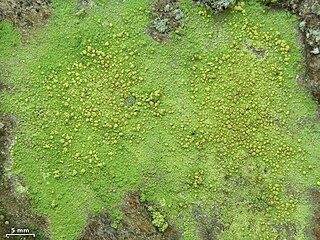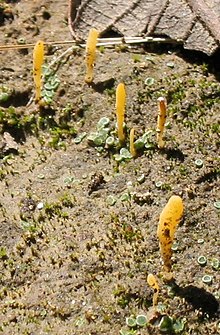
Basidiolichens are lichenized members of the division Basidiomycota within the subkingdom Dikarya of the kingdom Fungi. They form a diverse yet much smaller group of lichens than the far more common ascolichens of the division Ascomycota. Owing to how few described species there are, basidiolichens are generally considered to be poorly researched, and few studies that characterize their natural products exist. Biogeographically, basidiolichen species may be distributed in a cosmopolitan manner or more regionally, ranging from arctic and montane habitats to more temperate and tropical environments. Morphologically, basidiocarp and thallus structures may vary widely within and between basidiolichen genera.

Psilolechia is a genus of four species of crustose lichens. It is the only member of Psilolechiaceae, a family that was created in 2014 to contain this genus.
Dictyonema is a genus of mainly tropical basidiolichens in the family Hygrophoraceae.

The clavarioid fungi are a group of fungi in the Basidiomycota typically having erect, simple or branched basidiocarps that are formed on the ground, on decaying vegetation, or on dead wood. They are colloquially called club fungi and coral fungi.

Multiclavula is a genus of basidiolichens in the family Hydnaceae. The widespread genus contains 14 species. The genus was circumscribed by the American mycologist Ron Petersen in 1967, with Multiclavula corynoides assigned as the type species.
Ertzia is a monospecific genus in the family Lepidostromataceae. The sole species is Ertzia akagerae, a basidiolichen. The genus was circumscribed in 2014 by Brendan Hodkinson and Robert Lücking. Ertzia is distinguished from all other lichenized clavarioid fungi by having a microsquamulose thallus that forms contiguous glomerules with a cortex of jigsaw puzzle-shaped cells. Ertzia akagerae grows on soil in the African tropics.
Sulzbacheromyces is a genus of basidiolichens in the family Lepidostromataceae. The genus is distinguished from the other genera of Lepidostromataceae by having an entirely crustose thallus and from Multiclavula (Cantharellales) by having a chlorococcoid photobiont. The type species grows on soil in the neotropics.

Lepidostroma is a genus in the family Lepidostromataceae. The genus is distinguished from all other lichenized clavarioid fungi by having a distinctly squamulose thallus with scattered to dense rounded to reniform squamules. Four species are known from the tropics of Africa and the Americas.

A lichenicolous fungus is a member of a specialised group of fungi that live exclusively on lichens as their host organisms. These fungi, comprising over 2,000 known species across 280 genera, exhibit a wide range of ecological strategies, including parasitism, commensalism, and mutualism. They can be found in diverse environments worldwide, from tropical to polar regions, and play important roles in lichen ecology and biodiversity. Lichenicolous fungi are classified into several taxonomic groups, with the majority belonging to the Ascomycota and a smaller portion to the Basidiomycota. Their interactions with host lichens range from mild parasitism to severe pathogenicity, sometimes causing significant damage to lichen communities.
Savoronala is a fungal genus in the family Malmideaceae. It is monotypic, containing the single species Savoronala madagascariensis. This lichen produces unique conidia that each include a single algal cell.
James Donald Lawrey is a biologist, specializing in lichens. He is known for leading long-term monitoring projects, taxonomy and studies of the evolution of the fungi in lichens.

Multiclavula mucida is a globally distributed species of basidiolichen belonging to the family Hydnaceae. Since its initial classification by Christiaan Hendrik Persoon in 1797, the species has been described under various synonyms and associated with multiple genera. Persoon described its fruiting bodies as gregarious, varying from simple to branching structures, predominantly whitish in colour with yellow to brownish tips. He also noted its frequent appearance in autumn on decaying, moist wood, often covered with a greenish crust necessary for its growth.
Sulzbacheromyces leucodontius is a species of basidiolichen in the family Lepidostromataceae. First described in 2023, it is characterised by its distinctive white, unbranched fruiting bodies that resemble elephant tusks, growing 6–25 millimetres tall. The species forms a thin, crusty growth on clay soils in tropical rainforests, where it lives in symbiosis with microscopic green algae. It has the broadest geographical distribution of any American Sulzbacheromyces species, occurring across the Neotropics from Mexico to western Brazil, particularly in lowland areas. Although initially published as S. leucodontium, the species name was later corrected to S. leucodontius.
Sulzbacheromyces fossicola is a species of basidiolichen in the family Lepidostromataceae. First described in 1950 by E. J. H. Corner as Clavaria fossicola, it is characterised by its dark green to indigo blue crusty growth form and distinctive white, club-shaped fruiting bodies that turn beige when dried. The species forms a thin layer on soil or rocks, where it lives in symbiosis with microscopic green algae. It is distributed across tropical and subtropical Asia, from India to Singapore, where it specifically grows on exposed yellow and red clay soils in shaded locations. The species was transferred to Sulzbacheromyces in 2017 based on molecular and morphological evidence.
Sulzbacheromyces miomboensis is a species of basidiolichen in the family Lepidostromataceae. Found in the Democratic Republic of the Congo, as was described as new to science in 2017.
Sulzbacheromyces sinensis is a species of basidiolichen in the family Lepidostromataceae. It is found in Asia.
Sulzbacheromyces tutunendo is a species of basidiolichen in the family Lepidostromataceae. It is found in Colombia.
Sulzbacheromyces chocoensis is a species of soil-dwelling basidiolichen in the family Lepidostromataceae. It forms a thin, olive-green crust on clay soil and produces distinctive unbranched, reddish-orange to yellowish reproductive structures. The species was described in 2018 from specimens collected in Colombia's Chocó Biogeographic Region, where it grows in tropical rainforest environments.
Sulzbacheromyces caatingae is a species of basidiolichen in the family Lepidostromataceae. Discovered in 2012 in northeastern Brazil, it is characterised by its thin green crustose thallus and distinctive orange-pink, club-shaped reproductive structures. The species has a broad ecological amplitude, occurring across different vegetation types from the semi-arid Caatinga to humid Atlantic Forest fragments, where it grows on soil banks and termite nests near forest edges. As the type species of the genus Sulzbacheromyces, it represents a unique evolutionary lineage within the order Lepidostromatales and can be distinguished from similar-looking species by its undifferentiated thallus structure and association with green algae.

Lepidostroma vilgalysii is a species of basidiolichen in the family Lepidostromataceae. Discovered in 2012 in Mexico's Trans-Mexican Volcanic Belt, it grows in small green patches on clay banks in high-altitude pine forests. The species is distinctive because of its unusual "window lichen" structure, where its algal partner is concentrated in a layer at the base rather than near the surface as in most lichens. Its most distinctive features are its club-shaped reproductive structures, which are pale yellow to orange-brown with cream-colored tips, and its scale-like body parts that have white, raised edges. It is known only from a single location near San José Teacalco, Tlaxcala, at an elevation of about 3,000 m (9,800 ft) above sea level.






